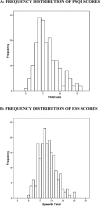Relationships between the Pittsburgh Sleep Quality Index (PSQI), Epworth Sleepiness Scale (ESS), and clinical/polysomnographic measures in a community sample
- PMID: 19110886
- PMCID: PMC2603534
Relationships between the Pittsburgh Sleep Quality Index (PSQI), Epworth Sleepiness Scale (ESS), and clinical/polysomnographic measures in a community sample
Erratum in
- J Clin Sleep Med. 2010 Feb 15;6(1):table of contents
Abstract
Study objectives: 1) To characterize PSQI and ESS scores, and their relationship to each other, in an adult community sample; 2) To determine whether PSQI and ESS scores, in combination with each other, were associated with distinct demographic, clinical, and sleep characteristics.
Methods: The PSQI, ESS, clinical rating scales, sleep diaries, actigraphy, and home polysomnography were collected from 187 community-dwelling adults (mean age 59.5 years, 47.1% women, 41.2% African Americans) as part of a study investigating novel cardiovascular risk factors. Correlations, cluster analysis, principal components analysis, MANOVA, ANOVA, and regressions were used to characterize the relationships between the PSQI, ESS, and other study variables
Results: Mean PSQI score was 6.3 (3.4), and mean ESS score was 8.2 (3.9). PSQI and ESS correlated weakly with each other (r = 0.16, p = 0.03), but segregated from each other on principal components analysis. Groups of participants categorized by either cluster analysis of PSQI and ESS scores, or by scores above or below traditional cut-off values, differed from each other on psychological/stress symptoms and quantitative and qualitative sleep diary measures, but not on actigraphic or polysomnographic measures. Specifically, higher PSQI scores were associated with female sex, greater psychological distress, and greater sleep disturbance on sleep diaries.
Conclusions: The PSQI and ESS measure orthogonal dimensions of sleep-wake symptoms, but neither is related to objective sleep measures. The PSQI is more closely related to psychological symptom ratings and sleep diary measures than the ESS. These instruments are not likely to be useful as screening measures for polysomnographic sleep abnormalities.
Figures



References
-
- Buysse DJ, Germain A, Moul D, et al. Insomnia. In: Buysse DJ, editor. Sleep Disorders and psychiatry. Arlington, VA: American Psychiatric Publishing, Inc; 2005. pp. 29–75.
-
- Roehrs T, Carskadon MA, Dement WC, et al. Daytime sleepiness and alertness. In: Kryger MH, Roth T, Dement WC, editors. Principles and practices of sleep medicine. 4th ed. Philadelphia: Elsevier Saunders; 2005. p. 39.
-
- Moul DE, Hall M, Pilkonis PA, et al. Self-report measures of insomnia adults: rationales, choices, and needs. Sleep Med Rev. 2004;8:177–98. - PubMed
-
- Buysse DJ, Reynolds CF, Monk TH, et al. The Pittsburgh Sleep Quality Index: a new instrument for psychiatric practice and research. Psychiatry Res. 1989;28:193–213. - PubMed
-
- Johns MW. Reliability and factor analysis of the Epworth Sleepiness Scale. Sleep. 1992;15:376–81. - PubMed
Publication types
MeSH terms
Grants and funding
LinkOut - more resources
Full Text Sources
Medical
